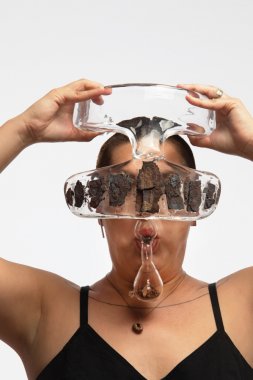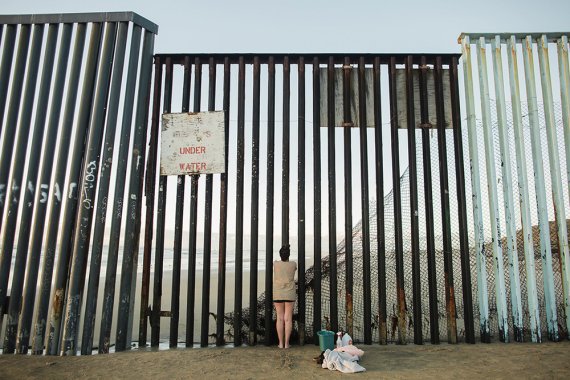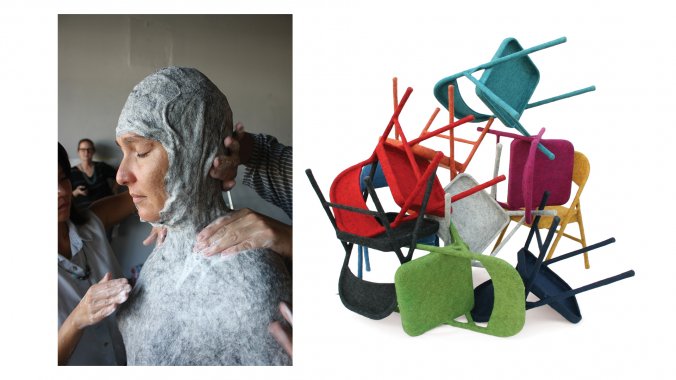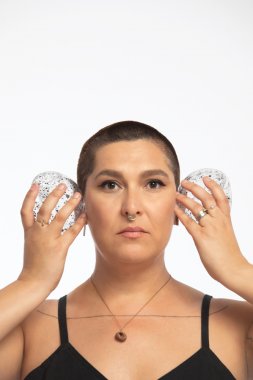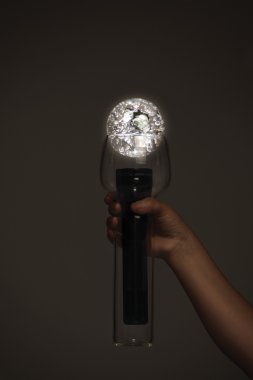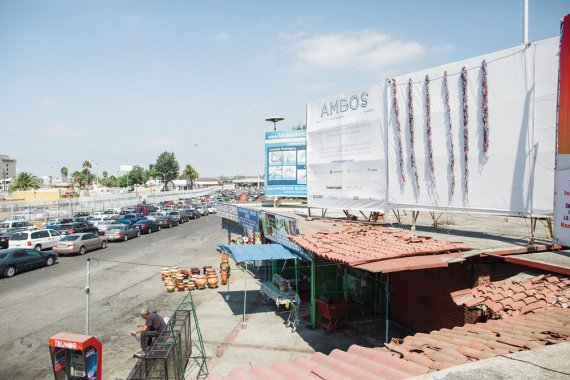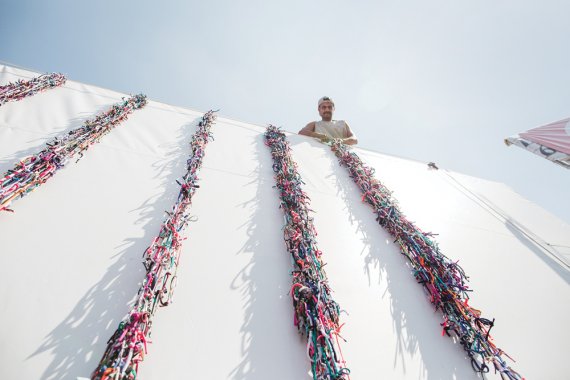Object Lessons
Object Lessons
For some, the US-Mexico border exists only in images they can turn away from. For others, it’s an ever-present part of their lives. With her ongoing collaborative project AMBOS, multidisciplinary artist and designer Tanya Aguiñiga is working to help the public better understand the experience of living on – and with – the border. An acronym for “art made between opposite sides” and the Spanish word for “both,” AMBOS invites artists to activate the border through collaborative artmaking, storytelling, listening, and witnessing.
For Aguiñiga, the work is personal. She grew up crossing the border from her hometown of Tijuana to San Diego, where she attended school for 14 years. Now the RISD graduate lives in Los Angeles, where she runs a diverse studio practice that ranges from custom tapestries, furniture, wearables, and sculpture to performance, political activism, and community collaboration. As an artist deeply invested in the impact of the border’s material and psychic reality, she’s often asked to be a spokesperson for the politics of the region, a role that can be emotionally taxing, if not continually retraumatizing.
We sat down on a cool Los Angeles afternoon to talk about the emotional labor of political activism and how a new body of work might help her “metabolize” her personal experiences.
You have a design background. I’m curious if you brought an inclination toward craft and care to your study of design, or if studying design compelled you to rethink what it could mean around care?
I think that is exactly the point I’m at right now. Especially being a mother. It’s made me really think about how you care for another. And it has made me really think about how one uses design as a way to set up successful outcomes, where you’re really setting people up to fall in love with a material and a process, and to find the solace in the meditative techniques that we use in craft.
You are infiltrating the object world with care!
Yes. Right now we’re working on a project where we use the five senses in relation to the border wall to start conversations about emotions and placemaking, or emotional placemaking, and how we as humans have a stake in the material world. I’m wondering how the physicality of things might help us work toward greater emotional understanding or an exploration of the space between people.
You know there’s a really nice term for those micro-moments and spaces; they are called the infrathin. Scholar and artist Erin Manning talks about them as slivers of experience that can barely be perceived but have resonance.
Yeah, that’s super-beautiful. I think that’s a thing when working in communal spaces – you’re aware of how we mirror each other’s emotions constantly. It’s like when you don’t speak the language of the place you are in, but you sort of feel your way into fluency.
What is interesting to me about making objects is what a powerful non-verbal communication tool they can be. People bring their own stories, regardless of whether they know why they were made, so I really like exploring objects as tools to open up dialogue.
That reminds me of the new body of work you made while a 2018 summer resident at Pilchuck Glass School.
So I didn’t fully think out the AMBOS project and what that would do to my own mental state, and how I’ve been retraumatizing myself constantly. I am intentionally being vulnerable and open in order to help other people, but I didn’t think about how much damage I could do to myself. I started thinking about how an emotional experience might get translated into materials or objects, and mirror and communicate those feelings to others. I kept thinking about how one deals with the s– that’s put on you and handed to you, and the physicality of that impact.
I didn’t know what I was going to make when I got to Pilchuck. The only thing I took with me, because I didn’t know how glass behaves or what I was going to want to make with it, was a box of pieces from the border wall. I physically broke off pieces of it in my hometown, which is where the wall dips into the ocean. Because the salt water decays the steel, I could just flake it off in large chunks. I took it with me, but didn’t know how I was going to use it.
I was there with another resident artist who said he worked in virtual reality, augmented reality, and “real reality.” I thought that was such a crazy-bleak way to deal with being – that people might start interacting with the world only virtually, and not actually experiencing life. So I asked myself, “What if I did an analog VR headset, so that no matter where you are, wherever you look, if you are wearing this headset you are forced to see the world through the slats of the border fence?” I wanted to figure out how to force someone to deal with this reality through all the senses, to experience metabolizing trauma related to the fence, and also to personally deal with how I can keep going back over and over to the border, how my body can actually survive that.
Survive continuing to work on AMBOS, or survive knowing that the border wall persists?
Both. I didn’t realize that when I started working on AMBOS it would turn into wearing on the outside all the stuff that I feel on the inside. I’m asking myself, “How do I share this experience? How do I share the weight of this with others so that I’m not the only one trying to carry this burden?” When there are so few people of color doing crafts, I’m already called upon too much to do the work of diversifying the conversation. And now, whenever people want to talk about art on the border …
Now you’re the representative of both “border art” and a “diverse” craft field.
I have to keep telling people that there have been people making art at the border and about borders for a long time. This is not new. When something is viral, people think it is a new phenomenon, and I want people to just step back and spend a little bit more time thinking.
So your “analog” headset doesn’t allow the wall to fade from view the way an image of it can. Once that wall or fence is in front of your eyes, it’s there permanently.
It’s also the power of the weight of materials. You realize, “This is really heavy and really difficult to wear. This is really painful to have on my body.” One part of the piece is a glass snorkel that you wear in your nose and mouth, and it gags you. It’s really difficult to breathe.
The entire body of work from Pilchuck, which you call a suit, consists of a “real reality” headset, a snorkel, a backpack, sound-amplification ear cones, and sandals – all made of glass and embedded with objects found at the border. You’ve talked about putting it on and wearing it at the border as an art piece. Will you ever ask others to wear it?
I think at the beginning I wanted other people to wear it, but the more I’m around it and think about it, I think that’s my baggage. So, when I’m ready, I’m just going to wear it with one person documenting it. I think that it is such a personal and painful piece that I don’t want it to be a spectacle. I just want to be able to work through a lot of the emotions myself.
It’s a private endeavor.
Yeah. I think that once the documentation is released, I’m fine with it being shared and the pieces being exhibited. But what’s important to me is to go through it. And it’s really funny – for a grant I recently wrote, I accidentally used “metastasize” instead of “metabolize,” which is also really telling and accurate. How does a body process trauma? Does it process it, or does it grow?
How would you talk about craft’s capacity to explore identity issues? I think for a lot of us it connects to labor. It connects to unseen labor, the unseen laborer, emotional labor. A lot of us use craft as a way to deal with trauma and institutional racism and how American society has been set up and how we feel as outsiders to that.
In your practice and your commitment to feminism and immigration and identity politics, you do a lot of emotional labor. And you make that an important part of how you run your studio, including who you hire and how you treat and collaborate with them.
I think a lot has to do with being a woman and being Mexican, and what I grew up with, like my aunts working as caretakers for other families and caring for the elderly and for young children, doing housekeeping jobs.
A lot of work that is classified by American society as “substandard” has connection to actual physical materials like dishrags and little cloth diapers and brooms and mops: all this different stuff that, to me, has so much class weight that it makes for a fertile place to start conversations from. And within that, I think about how the working class – people don’t acknowledge their presence. So those people, those workers, go around as ghosts.
Women’s lives especially have been subjugated to those roles. Sometimes without us ever really knowing.
So maintenance work happens in the shadows?
Yeah, materially and emotionally. But also the maintenance of our own female bodies and how that also involves the care of mental health.
I really like being able to talk about those things and bring them out into the open in the studio. We’re not a place where women are pitted against women. We’re a place that’s thinking about family structures and how diversity within family structures leads to healthier environments. We’re thinking about intergenerational trauma, immigrant histories, love in the labor of cooking together, and how that relates to how we weave together. So there’s a lot of nurturing through the process of making stuff.
I was thinking about how Tijuana for a long time was primarily a maquiladora town, a town that makes products for the rest of the world and suffers for other people’s luxuries. I think a lot about the luxury of making art, making decorative objects for rich people, and really take to heart that when building a studio, nobody should suffer for the making of these luxury items. I want to make a place that’s really comfortable and supportive.
What are you excited about in craft right now?
I’m really excited about working with Cannupa Hanska Luger at the border with the Native American community. I’m still really excited about Roberto Lugo’s work and how he uses craft as a place to talk about really emotional personal history. I think whenever I see other people being really vulnerable and personal through their work, that gives me hope. There’s something really nice about knowing that you’re not alone.


